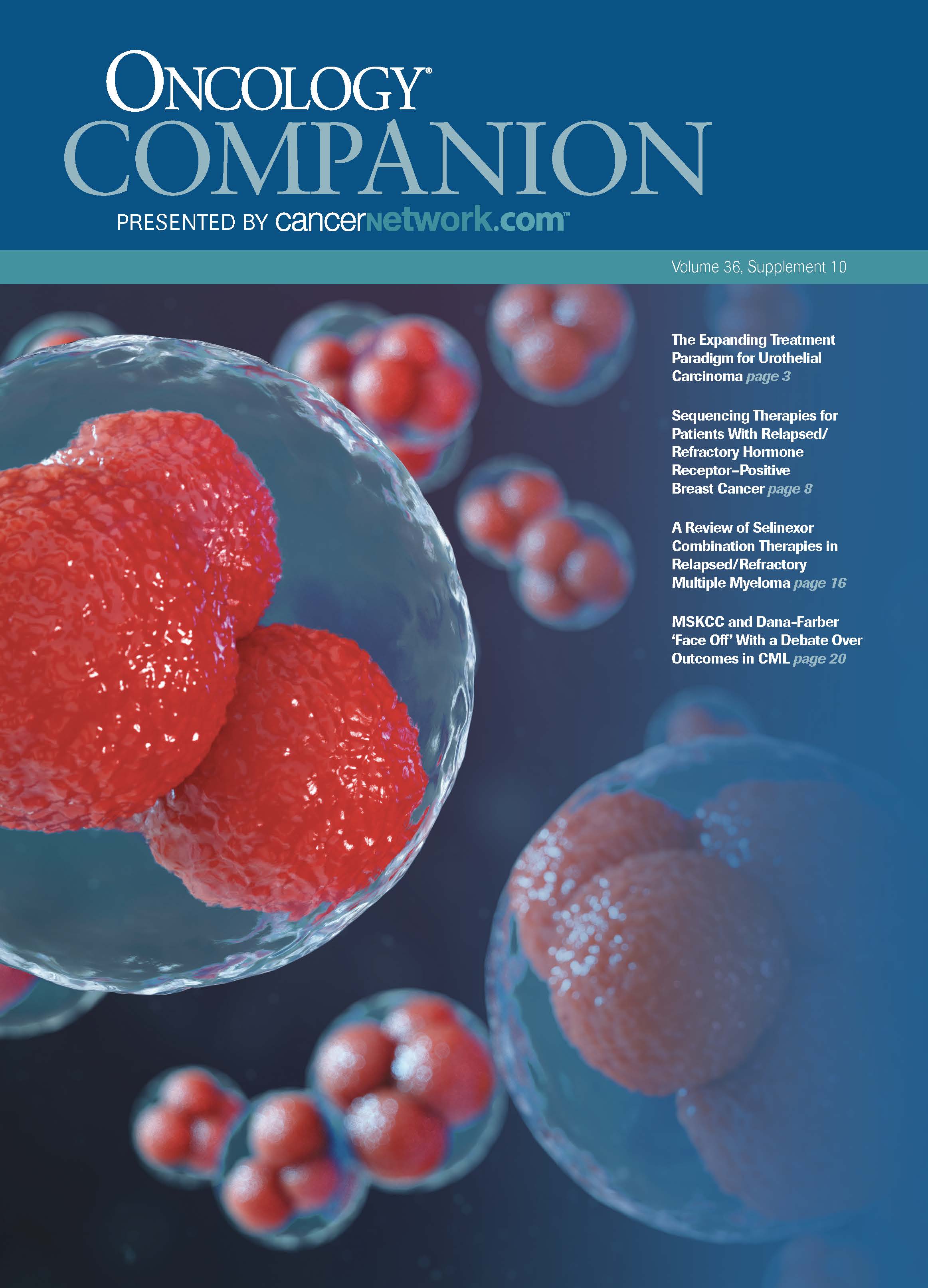Recap: Sequencing Therapies for Patients With Relapsed/Refractory Hormone Receptor–Positive Breast Cancer
Martin Dietrich, MD, PhD, Sara Tolaney, MD, MPH, and Gregory Vidal, MD, PhD review recent data from the TROPiCS-02 trial on sacituzumab govitecan and discuss the clinical implications of these findings.

Research into novel therapies for the treatment of hormone receptor (HR)-positive, HER2-negative breast cancer has brought many nonchemotherapeutic treatments to the fore, leaving clinicians with a wide array of options for their patients in this setting.
In a Between the Lines segment hosted by CancerNetwork®, Sara M. Tolaney, MD, MPH, chief of the Division of Breast Oncology and associate director of the Susan F. Smith Center for Women’s Cancers at Dana-Farber Cancer Institute, as well as associate professor of medicine at Harvard Medical School in Boston, Massachusetts, sat down with colleagues Martin Dietrich, MD, PhD, and Gregory Vidal, MD, PhD, to discuss optimal sequencing of available agents and their strategies for treating patients whose disease has progressed following standard frontline therapy. Dietrich is a medical oncologist at Florida Cancer Specialists and Research Institute and an assistant professor of internal medicine at the University of Central Florida in Orlando. Vidal is an oncologist at the West Cancer Center and Research Institute in Memphis, Tennessee.
Treatment Sequencing for HR+/HER2– Breast Cancer
Early in their discussion, the panelists generally agreed that standard treatment of patients with HR-positive, HER2-negative breast cancer in the frontline setting involves a CDK4/6 inhibitor regimen followed by hormonal therapy, such as an aromatase inhibitor. The tricky part comes when patients progress.
“I’m happy about the opportunity to have additional therapy opportunities, but how to sequence them and what that optimal sequence [looks like] are going to be very challenging,” Dietrich said. “Aside from efficacy, we’re going to be considering adverse effects [AEs], convenience, and the nature of progression.”
Dietrich went on to consider, for instance, a patient with bone-only disease who had a prolonged response to CDK4/6 inhibition, then experienced mild bone progression. In this case, a subsequent line of therapy with an mTOR inhibitor plus fulvestrant or a PI3K inhibitor regimen in a biomarker-driven setting may be appropriate.
Other options include the recently approved fam-trastuzumab deruxtecan-nxki (Enhertu; T-DXd) in patients with unresectable or metastatic breast cancer with low levels of HER2 expression, based on data from the phase 3 DESTINY-Breast04 trial (NCT03734029) that showed a statistically significant improvement in progression-free survival (PFS) with the agent vs physician’s choice of chemotherapy.1,2 Patients whose tumors do not harbor a traditional biomarker for treatment can receive sacituzumab govitecan-hziy (Trodelvy), which is an antibody-drug conjugate (ADC) that targets the cell surface antigen Trop-2, with evidence of efficacy in this space centering around the TROPiCS-02 trial (NCT03901339).3
“It’s a paradigm shift in the way we think about targeting cancer, because we’ve always thought about finding an oncogenic driver [first], then figuring out a way to turn off that driver,” Tolaney said. “Now with the examples of T-DXd for HER2- low expression—which is not driving the cancer—and similarly with Trop-2, just knowing there’s a target allows us to have targeted delivery of therapy, which has proven to be so useful in breast cancer.”
Optimal Setting for Sacituzumab Govitecan
Based on early data suggesting sacituzumab govitecan-hziy had efficacy in not only the triple-negative but also the HR-positive breast cancer space, the phase 3 TROPiCS-02 trial was undertaken to confirm its advantage vs physician’s choice of chemotherapy. Patients had HR-positive disease and were heavily pretreated with 2 to 4 lines of prior therapy, including at least 1 each of a taxane, hormonal therapy, and CDK4/6 inhibition. Results showed that among 543 patients randomly assigned in a 1:1 fashion, the blinded independent central review–assessed median PFS was significantly improved with the Trop-2 inhibitor therapy (5.5 months vs 4.0 months, respectively; hazard ratio, 0.66; 95% CI, 0.53-0.83; P = .0003).
Results at the first interim analysis for median overall survival (OS) indicated sacituzumab govitecan-hziy vs standard of care did not result in statistically significant benefit (hazard ratio, 0.84; 95% CI, 0.67- 1.06; P = .14). However, results of the second interim analysis were presented at the European Society for Medical Oncology Congress 2022, showing a meaningful improvement in median OS with sacituzumab govitecan-hziy for this patient population at 14.4 months vs 11.2 months, respectively (hazard ratio, 0.79; 95% CI, 0.65-0.96; P = .020).4
Looking at the OS and PFS data together, Dietrich pushed for considering sacituzumab govitecan-hziy earlier in the sequence of treatment, as the emergence of statistically significant OS results reassures physicians that this is, in fact, favorable treatment for their patients. “With an OS benefit, I would not reserve it for a late-line setting. It’s an agreeable drug with AEs we can manage,” he said.
Tolaney pointed out the heavily pretreated nature of this population, for which most patients received 3 or more lines of therapy in both the active (58%; n = 159) and control groups (56%; n = 151), which explains why the PFS benefit of approximately 1.5 months may appear underwhelming. “This is in [patients] who have 3 prior lines of chemotherapy, suggesting we do need better therapies here,” Tolaney said. “Seeing this incremental benefit—well, modest at least—is a movement forward.”
Vidal echoed that sentiment by comparing the results seen with sacituzumab govitecan-hziy with T-DXd. “[In] DESTINY-Breast04, patients had to have only 1 or 2 prior chemotherapy agents, [whereas TROPiCS-02] was from 2 to 4. It’s a completely different population, [which] may explain some of the differences we see there.”
“Placement and sequence are going to be big discussions. [Only time will tell] how this is going to shake out overall, but I believe earlier usage of sacituzumab govitecan is going to allow the drug to exert a much broader effect than what we’ve seen in TROPiCS-02,” Dietrich said. “Since the design [of the trial] was stacked against the drug in terms of outcomes, I hope we will be able to place it earlier in our clinical setting and make better use of it than we’re seeing right now.”
One interesting consideration that has emerged since T-DXd and sacituzumab govitecan-hziy have shown benefit in an overlapping patient group is the shared characteristics in their mechanism of action, namely their activity against topoisomerase 1 (Topo-1). Tolaney pointed out that TROPiCS-02 was conducted at a time when patients “weren’t receiving prior [agents with a] Topo-1 payload and then sequentially going on to receive another Topo-1 payload. In the modern era, this will probably [account for approximately] two-thirds of our patients with [HR]-positive disease and HER2-low expression.”
Vidal continued by pointing out that patients in this setting could present with HER2 status that is 0 or unknown, and rerunning a tissue biopsy could be prohibitive in certain circumstances. In that case, he said he would prefer to go with sacituzumab govitecan-hziy and reiterated the positive OS data. “I fully agree,” Tolaney said. “Target expression comes up a lot, [because] it’s a challenge to figure out who has HER2-low expression or lack of quantitation of HER2 to tease this out.”
Tolaney went on to briefly describe results from the phase 3 ASCENT trial (NCT02574455) of sacituzumab govitecan-hziy in patients with relapsed/ refractory metastatic triple-negative breast cancer that showed medium to high expression of Trop-2 conferred greater efficacy of sacituzumab govitecan-hziy, although the trial was not powered to conclude this.5
“Understanding the expression would be important. Ultimately, I don’t think it’s going to guide whether we give those patients the drug. We do see even the low [expressors having] some activity, and hopefully we will see the same thing in TROPiCS-02,” Vidal said.
Future Directions
Dietrich said optimal sequencing for these patients with relapsed/refractory HR-positive breast cancer is going to be individualized and will rely on what’s discovered in further research going forward.
“The future for breast cancer and ADCs as a whole is bright, because we’re recognizing that we can target these cancers with smaller amounts of chemotherapy and hopefully do less damage to normal cells,” Vidal said. Opening the door to future research efforts may optimize current medications by administering them in combination with other agents.
“There’s just so much we have to learn, but it’s exciting to have these opportunities to improve outcomes for our patients,” Tolaney said.
References
- Modi S, Jacot W, Yamashita T, et al. Trastuzumab deruxtecan in previously treated HER2-low advanced breast cancer. N Engl J Med. 2022;387(1):9-20. doi:10.1056/NEJMoa2203690
- FDA approves fam-trastuzumab deruxtecan-nxki for HER2-low breast cancer. FDA. August 5, 2022. Access October 20, 2022. https://bit.ly/3EYYdpV
- Rugo HS, Bardia A, Marmé F, et al. Sacituzumab govitecan in hormone receptor–positive/human epidermal growth factor receptor 2-negative metastatic breast cancer. J Clin Oncol. 2022;40(29):3365-3376. doi:10.1200/JCO.22.01002
- Rugo HS, Bardia A, Marmé F, et al. Overall survival (OS) results from the phase III TROPiCS-02 study of sacituzumab govitecan (SG) vs treatment of physician’s choice (TPC) in patients (pts) with HR+/HER2- metastatic breast cancer (mBC). Ann Oncol. 2022;33(suppl 7):S808-S869. doi:10.1016/annonc/annonc1089
- Bardia A, Tolaney SM, Punie K, et al. Biomarker analyses in the phase III ASCENT study of sacituzumab govitecan versus chemotherapy in patients with metastatic triple-negative breast cancer. Ann Oncol. 2021;32(9):1148-1156. doi:10.1016/j.annonc.2021.06.002
EP: 1.Article Introduction and HR+/HER2 mBC Background
EP: 2.The Role of Trop-2 in mBC and the Rationale for Use of Trop-2–directed ADCs
EP: 3.TROPiCS-02 Study Overview and Patient Baseline Characteristics
EP: 4.PFS and OS Data from TROPiCS-02
EP: 5.TROPiCS-02: PFS Subgroup Analysis, Summary of Response Rates, and AEs
EP: 6.Key Takeaways & Clinical Implications
EP: 7.Recap: Sequencing Therapies for Patients With Relapsed/Refractory Hormone Receptor–Positive Breast Cancer

Navigating AE Management for Cellular Therapy Across Hematologic Cancers
A panel of clinical pharmacists discussed strategies for mitigating toxicities across different multiple myeloma, lymphoma, and leukemia populations.